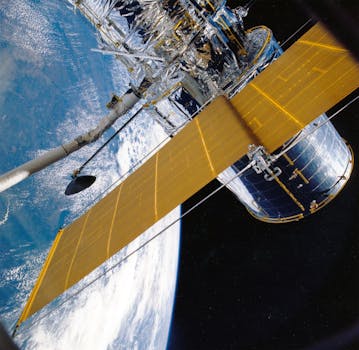The Rise of Mega-Constellations: Latest Updates in Satellite Telecommunications

The Rise of Mega-Constellations: Latest Updates in Satellite Telecommunications
The rise of mega-constellations is revolutionizing the field of satellite telecommunications, with numerous companies launching thousands of satellites into low Earth orbit to provide global internet coverage. The focus keyword, Satellite Telecommunications, is at the forefront of this revolution, enabling the deployment of mega-constellations that promise to transform the way we communicate and access information.
Mega-constellations are clusters of satellites that work together to provide high-speed internet connectivity to remote and underserved areas around the world. These constellations are designed to be highly efficient and cost-effective, using advanced technologies such as phased arrays and digital beamforming to provide high-gain and high-throughput communications.
History of Satellite Telecommunications
The concept of satellite telecommunications dates back to the 1960s, when the first commercial communications satellite, Intelsat 1, was launched into geostationary orbit. Since then, the industry has evolved significantly, with the development of new technologies and the launch of numerous satellites into various orbits. The rise of mega-constellations is the latest chapter in this story, with companies such as SpaceX, OneWeb, and Amazon’s Kuiper Systems leading the charge.
These companies are launching thousands of satellites into low Earth orbit, which is approximately 200-800 kilometers above the Earth’s surface. This orbit is ideal for providing high-speed internet connectivity, as it allows for low latency and high-throughput communications. The satellites are designed to be highly efficient and cost-effective, using advanced technologies such as solar panels and ion engines to reduce their mass and increase their lifespan.
Benefits and Challenges of Mega-Constellations
The rise of mega-constellations promises to bring numerous benefits to the field of satellite telecommunications. One of the most significant advantages is the ability to provide high-speed internet connectivity to remote and underserved areas around the world. This can help to bridge the digital divide, enabling communities to access information, education, and economic opportunities that were previously out of reach.
However, the deployment of mega-constellations also poses significant challenges. One of the most pressing concerns is the risk of space debris, which can be caused by the launch of thousands of satellites into low Earth orbit. Space debris can pose a significant threat to the safety of spacecraft and satellites, and can also contribute to the growing problem of space pollution.
Another challenge is the need for spectrum allocation and management. The deployment of mega-constellations requires the allocation of large amounts of radio frequency spectrum, which can be a limited resource. The management of spectrum allocation and use is critical to ensuring that the satellites can operate effectively and efficiently, without interfering with other satellite systems or terrestrial networks.
Latest Updates and Developments
The field of satellite telecommunications is rapidly evolving, with numerous companies and organizations working to develop new technologies and launch new satellites. One of the most significant developments is the launch of SpaceX’s Starlink constellation, which promises to provide high-speed internet connectivity to remote and underserved areas around the world.
Another significant development is the launch of OneWeb’s constellation, which aims to provide global internet coverage and connectivity to remote and underserved areas. The company has already launched numerous satellites into low Earth orbit and is working to deploy its full constellation in the coming years.
The rise of mega-constellations is also driving innovation in the field of space technology, with numerous companies and organizations working to develop new technologies and systems. This includes the development of advanced propulsion systems, such as ion engines and Hall effect thrusters, which can help to reduce the mass and increase the lifespan of satellites.




